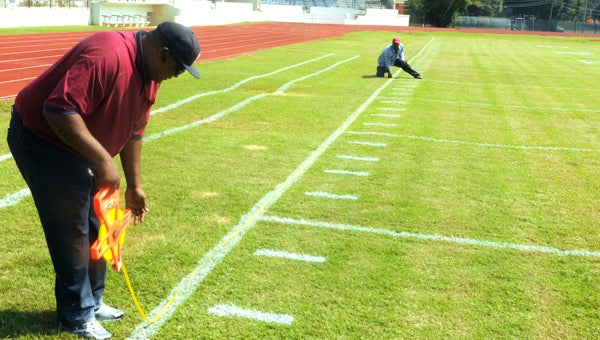Plenty of hours, and paint, go into getting football fields ready
Published 10:27 pm Thursday, August 29, 2013

Johnny Jemison, left, and Alonzo Jones double check their measurements as they finish up preparations at Memorial Stadium for Friday’s Southside versus Selma game. Jemison has been helping get the field ready for 25 years, while Jones has done it for 27 years. — Daniel Evans
Memorial Stadium will be packed Friday evening, as students and fans of the Southside Panthers and Selma Saints, in one of the county’s best rivalries, find their seats. But, even as those fans get set for the game, they should not overlook all the work that was put in to get the stadium — and the field — ready for kickoff.
Workers from the Selma City Parks and Recreation Department were on the field bright and early Thursday, preparing the Memorial Stadium field and getting it ready for the first time this year.
Elton Reece, department director, said preparing the field is a year round exercise, because it has to be periodically fertilized, watered and irrigated among other things.
“The first game of the year, it takes a long time to do it, because we have to sit down and draw out all the lines,” Reece said.
Selma High School, R. B. Hudson Middle School, Concordia College Alabama and Ellwood Christian, and the city’s youth football league, call Memorial Stadium home, so throughout the year a lot of work has to be done to get the field ready and keep in playing shape.
Since paint is used for all the lines, hash marks and numbers, Reece said it is easy to run through a lot of paint in a short period of time. Over the course of the year, Reece said the city orders about $7,200 worth of paint. Each time they order, they get 28, 5-gallon buckets.
“The field preparation is probably the most expensive the first time, because it takes about 90 gallons of paint. Of course, the field preparation is only part of it,” Reece said. “Then, you have to get the stadium ready. A lot of times we will have games back to back [Thursday and Friday night].”
On a typical week, the Memorial Stadium field is cut two to three times a week. When a middle school team plays on Tuesday, the field crew typically touches up the paint on Monday, barring rain that may cause the grass to grow too much and force an extra cutting.
“After the initial one, when you get the numbers down and all the lines, we just come back in and run back over it,” Reece said. “[However], if you get rain four or five days in a row and the grass grows up an inch or two, it raises all the paint up and if you cut all that paint off, you have to re-do it all.”
Reece said that’s only part of the work though. Every time they also check the scoreboards, public address system and 30-second clock. After youth games on Saturdays, they come in to clean up the field.
Although Southside does not play at home this week, the Panthers already have a plan in place for their first home game. Southside has a volunteer field crew who helps get things ready to go, but on weekends assistant coach William Skinner comes in to cut the field.
“We have a field crew who comes out and paints our field for us,” Southside head coach Daniel Flowers said. “Each time we get our field painted, it costs us $250. That’s not manpower, that’s just the cost of paint.”
In Plantersville, at Dallas County High School, the Hornets are preparing to host Calhoun Friday. Hornet head coach Barry Colburn said after working in football for as long as he has, he can usually “eye ball” painting the field pretty well, reducing the time it takes to do it.
“I usually spend all day Thursday getting our field ready for Friday night, so it will look as nice as it can look for the people that come out to watch the ballgame,” Colburn said.
Even with all of his experience at preparing fields for game days, Colburn said it takes a lot of hard work to get to the end product.
“People come in on Friday night and say ‘Oh man, the field looks great,’” Colburn said. “They just don’t realize what it took to make it look great. They get to see the end product.”


